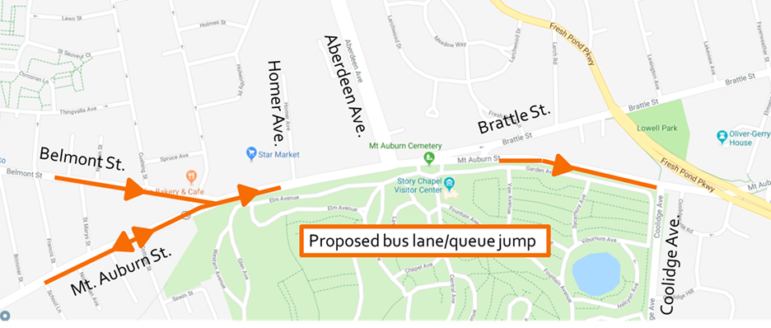
The locations of the new Bus Rapid Transit lanes.
The following piece was provided by State Sen. Will Brownsberger (D – Belmont) who represents Watertown:
Thousands of commuters on Mount Auburn Street and on Fresh Pond Parkway had a very rough ten days starting on Monday, November 5. That is the day that a contractor swapped in a new controller for the traffic signals and failed to properly program it.
The new Siemens 60 signal controller is so sophisticated that only a few engineers have the expertise to properly program it. Commuters endured ten days of bad timing until the right specialist was able to get it working as intended.
As of Thursday, Nov. 15, DCR engineers believe that the signals should continue to run reliably (until natural disaster strikes or humans again intervene).
With the lights working properly, we can now assess the operations of the new bus lanes along Belmont and Mount Auburn Streets near Mount Auburn Cemetery. For the last 10 days, motorists have understandably been blaming the bus lanes for the delays, but I hope motorists will take another look now that the signal timing has been corrected.
The analysts who modeled the bus lanes before implementation believe that they will help buses without degrading the experience of motorists for two reasons.
First, much of Mount Auburn Street east bound between Belmont Street and Fresh Pond Parkway was almost a single lane already. There are four left turns for cars going east in that stretch — into Star Market and at Homer, Aberdeen and Brattle. At rush hour, there are frequently cars waiting to turn left and through-traffic has to weave around them. So, the effective capacity of the stretch for automobiles was already not so much more than that of a single lane. The intermittent bus lane preserves much of that capacity.
Second, Cambridge and DCR have made important changes in how the traffic signals operate. The light at Coolidge Avenue has historically given 43 seconds of green time to inbound motorists on Mount Auburn at rush hour. However, the immediately following light at the big Fresh Pond intersection offered only 31 seconds to those motorists. That Fresh Pond light has been the real limit on throughput.
To protect Mount Auburn drivers while adding the bus lane, DCR has boosted the time allocated to Mount Auburn Street at Fresh Pond from 31 seconds to 43 seconds, enough to make a big difference in the throughput on Mount Auburn Street. Additionally, Cambridge has improved coordination at the other lights on Mount Auburn so that traffic in both directions should flow more smoothly.
Green time at an intersection is a zero sum game: The traffic on Fresh Pond Parkway loses 12 seconds of green time in the changes, going from 58 to 46 seconds at the crossing of Mount Auburn Street. However, that traffic already had only 46 seconds to cross Brattle Street, so the throughput across those combined intersections should remain roughly the same.
That’s the basic give and take in the morning rush hour on weekdays. Buses filled with people standing up should now be able to move through much more quickly. Drivers on both Mount Auburn and Fresh Pond Parkway should see very limited changes in their actual end-to-end travel time.
I very much hope that motorists who experience unreasonable delays near these intersections will continue to let me know so that I can provide feedback to the engineers.
My cell is 617-771-8274 and my email is william.brownsberger@masenate.gov. Commuters can also always comment publicly at willbrownsberger.com.
Coming in our next construction season is a set of further changes for the Fresh Pond intersection that should improve both safety and throughput.
See prior posts in this thread for additional background.

What we needed was a solution not a few seconds. Either Brattle St or Fresh Pond Pkwy at their intersection should have been tunneled. That would have solved virtually the entire problem. The current signal solution is a band aide at best.